In most parts of the world, the leaves are turning, the days are getting shorter and it’s a fresh 14 degrees or so. Pumpkins and all things orange, russet and gold are the rage. Desserts too are the norm – pumpkin pies and apple tarts, custards, puddings and heartwarming eats.
In Nigeria, some leaves are turning but the days stay the same. There are no falling temperatures, only rain…and bucket loads of it. And dessert is…..well, not a common third course at the family table.
The fruits develop and ripen quickly, only 3 weeks after the flowers open. In Brazil, the plants bloom in September and fruits ripen in October; they bloom again in December and January. In Florida and the Bahamas, there is a spring crop, March or April through May or June; and a second crop, September through November, coinciding with the spring and fall rains.
All of a sudden I’m pining for fall. Pining hard thinking of pumpkin carving, thick soups of root vegetables, good books and tartan blankets. I’m longing for the beauty and the brightness of the sun like only autumnal sunshine can be, leaves flying about like specially designed fall blankets. I see myself springing high up in the air, legs folded back and arms lifted in a declaration of turning seasons and new beginnings. I want to land in a thick pile of leaves with no fear of snakes slithering…to scare me.
Instead the cherries, bright red and orange comfort me. Usher in my autumn. Let me feel loved and not so lonely.
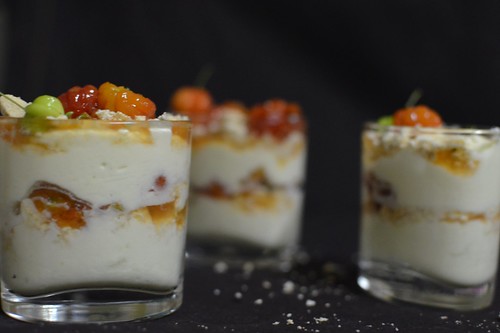
It’s amazing what we would do for cherries. By we, I mean Yemisi and I. Both food bloggers, living in different towns in Nigeria. Both with shared vision and a common goal – get those sweet, juicy cherries off the tree!!
The Suriname Cherry, Brazilian Cherry, or Cayenne Cherry (Eugenia uniflora) is a plant in the family Myrtaceae, native to tropical South America’s east coast from Suriname to southern Brazil. Known as Pitanga throughout Brazil or Ñangapirí in surrounding countries, it is a large shrub or small tree with a conical form, growing slowly to 8 meters in height.
The leaves are glossy green, up to 4 cm long, and new leaves are copper-colored. Fragrant white flowers mature into reddish fruits up to 2 cm in diameter. The taste ranges from sweet to sour, depending on the cultivar and level of ripeness (the darker red to black range is quite sweet, while the green to orange range is strikingly tart). The plant is relatively pest resistant, easy to grow and high in antioxidants.
The Suriname Cherry is often used in gardens as a hedge or screen.
The fruit is high in Vitamin C, and its predominant food use is as a flavoring and base for jams and jellies. The tree was introduced to Bermuda for ornamental purposes but is out of control, and is now listed as invasive in Bermuda.
One skips church to lay her hands on the most delicious of cherries (Yemisi) and I…..well, I ditched lunch for this fruit ( you know I don’t joke with my food!), spent an evening roaming the streets of a certain estate….looking for them!
Yemisi writes: ‘I have my own rebellious ideas about butter and jam that have nothing whatsoever to do with joyless products sold in foil wrappers and glass jars in supermarkets. On Sunday morning, I skive from church and go cherry picking in my neighbour’s garden: Pitanga cherries, also known as Surinam cherries grow from trees that Nigerians like to tame, trim and keep as hedgerows but rarely consider worthy to be regarded as fruit or food’.
I, Ozoz found a compassionate hand and got him to ‘pluck’ cherries off trees for me. Trees bursting with low-hanging fruit. But that’s nowhere near enough and so I enlist my husband, egged on by my cherry-loving children to go on an evening hunt, let’s call it ‘Family time’. We arrive at the hedges that are ripe for the picking and he hoists a daughter on his head. She reaches for red cherry after red cherry, the excitement of sitting on her father’s head sufficient to energise her.
This cherries take me back to my childhood and I can’t decide whether my longing for them is a wistful desire for the past, or if my food-loving ways are what draw me to them in the present, in the here and now. Does it even really matter why I want them, what my motive is? These are the cherries of my youth. Memories stained with fragrant juices that run red and down fragile arms. The scents transport me to a time when I ‘was’ and somehow reminds me of ‘who I used to be’, and who I still am.
I love the fact that we currently live in Port-Harcourt, a city where I spent a part of my childhood. It means I can show my children the veranda I sat under in the house I lived in; that we can ‘pluck’ pitanga cherries off the trees that I plucked them of as a child, that we can play with the ‘touch-me-nots’ plants, as they open and close. It means too that we can discover new things together like tree squirrels dancing on tree branches, things that make it not only my place, but our place.
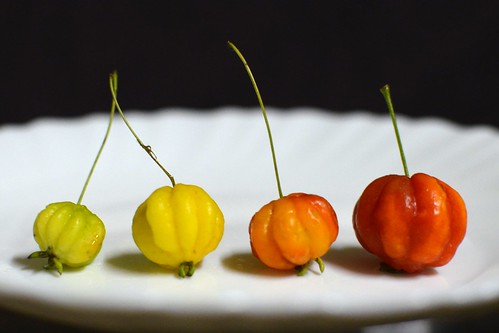
Children enjoy the ripe fruits out-of-hand. For table use, they are best slit vertically on one side, spread open to release the seed(s), and kept chilled for 2 or 3 hours to dispel most of their resinously aromatic character.
If seeded and sprinkled with sugar before placing in the refrigerator, they will become mild and sweet and will exude much juice and serve very well instead of strawberries on shortcake and topped with whipped cream.
They are an excellent addition to fruit cups, salads and custard pudding; also ice cream; and can be made into pie or sauce or preserved whole in syrup.
They are often made into jam, jelly, relish or pickles. Brazilians ferment the juice into vinegar or wine, and sometimes prepare a distilled liquor.
Pitanga cherries are interesting. They look like thin-skinned tomatoes, have subtle pepper tones and yet are fruits….Fruits that make me want to think ‘dessert’, yet would be more at home in a salsa, in some savoury offering. The taste of this cherries are embossed on my lips, slightly peppery, somewhat sweet. Not quite tomato or strawberry. Not even ‘real’ cherry but loved passionately all the same. And all of a sudden, what was once the food of children playing has now become the desired, foraged ingredient. I’ve thought many things – syrup, vinegar, candied pitanga….but it is jam that is the most attractive of them all. And so jam it is, taking another leaf out of Yemisi’s book (the first being skiving off something – church or lunch).

Yemisi says…again:
‘Nigella Lawson in her book, How to Be a Domestic Goddess, suggests the simplest of methods for making jam. She puts the same quantity of sugar and fruit in separate oven dishes and cooks them in an oven. I put 600g of Pitanga skin and juice that I had separated from the seeds in one oven dish and 600g of granulated sugar in another. To the Pitanga, I add two star anises, cinnamon bark, a quarter of a teaspoon of coarsely ground black pepper and a quarter of a teaspoon of ground dried ‘hot’ Cameroonian pepper.
Nigella says to use Caster sugar, but (sugar na sugar, abeg) I use granulated, which is what I have. After about 30 minutes at 180 degrees, my sugar becomes dark caramel, and my fruit bubbles up and thickens. I then pour the liquid sugar into the hot cooking fruit. The result: Pitanga Jam. I pour the jam into two sterilized glass jars, seal, cool and refrigerate them.’
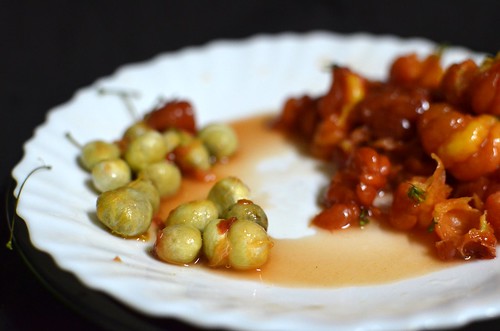
I followed her recipe to a pat – roast the pitangas in an ovenproof dish and the same weight of sugar into another oven proof dish. Half an hour later, there is roasted fruit and there is caramel both of which are stirred together to make jam.
In a perfect world….of course.
I am obviously not a domestic goddess for in my world, my caramel went past the soft ball stage and hardened. Truth be told, some of it behaved and combined itself with the roasted fruit but I did end up with big blocks of candy which made its way (albeit in a melted state) into the most delicious caramel ice cream ever!
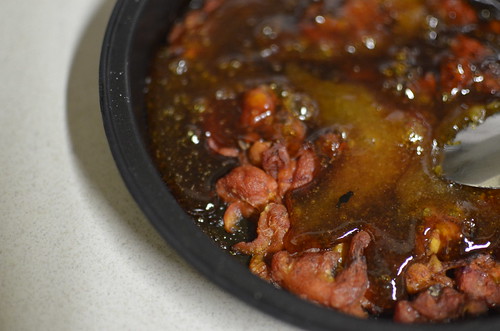
My resulting jam is like candy. For obvious reasons. The cherries however are wonderful. The flavours are amplified as roasting is wont to do. Peppery. Like strawberries with black pepper and balsamic, except the flavor is all its own – no help needed, save a pinch of vanilla powder.
But this jam is not sufficient for me. Somehow, just like with pineapples, I am leaning towards enjoying this fruit uncooked, untainted, pure.
I want the ruby red gorgeousness of it to shine. I want its stealth, fiery flavours to shine, shine shine….and I can think of no better way than to simply macerate it with sugar, let the resinous flavours subdue and get it on a pavlova. But that soon becomes a dream, one where a nice crisp meringue base, crumbles into pieces, perfect for the classic Eton mess….which has ‘beauty’ too on its side, served in creamy, not-fancy-at-all layers.
Because meringues, whole or broken can be peacemakers. Mediators. Meringues have the perfect contrast of textures, crisp yet pillowy, marshmallowy at the same time. With the ability to act as a blank canvas. They surrender to layers and layers of flavor and never once give complaint. I like the sweetness of a meringue, crushed and laying heavy on barely sweetened whipped cream. Cream that has been whipped and left just as cream should be. All these make room for the star, for the crowning glory that is fruit.
 Beautiful, macerated fruit.
Beautiful, macerated fruit.
The finished dessert is pretty, if somewhat scanty on fruit. For that was all I could forage!
And the taste?
‘Just there’. Absolutely nothing special!
My daughter (#1) who loves food, loved it.
But I, knowing how I first met this fruit…was not enamored, even indifferent. It was a very middle-of-the-road effort.
It may have looked pretty but it was ‘tasteless’. Neither the cream nor the meringues could have helped the cherries.
Some things are best left alone.
Pineapples (till I can be convinced otherwise) and Pitanga cherries.
Have you tried Pitanga cherries before?


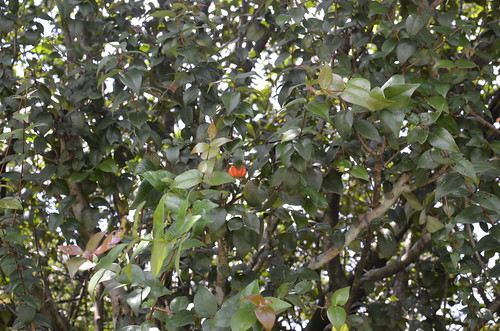
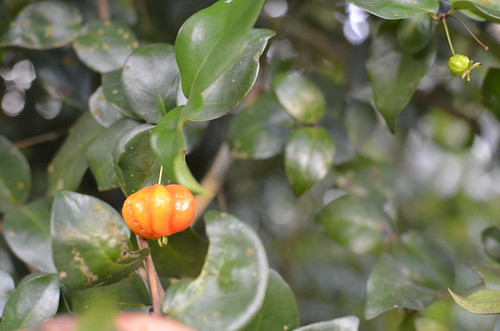
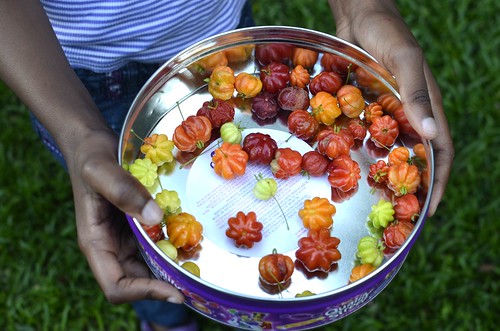
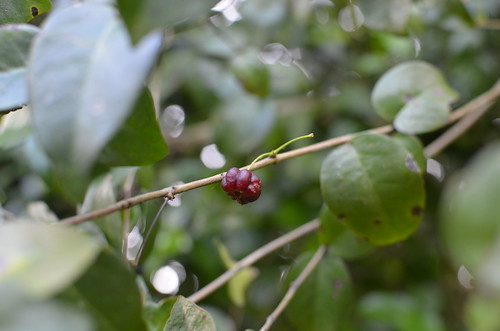

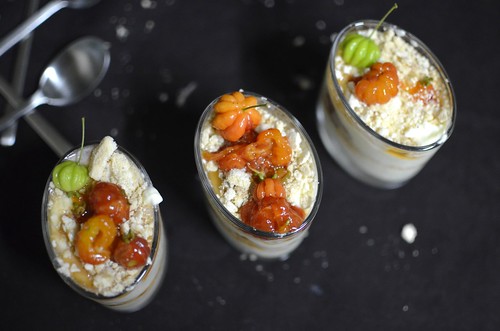
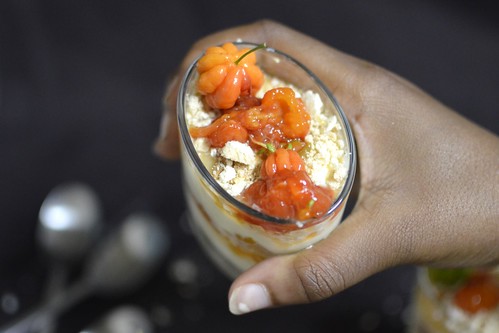
Leave a Reply